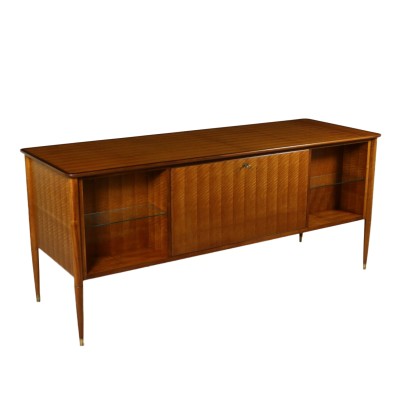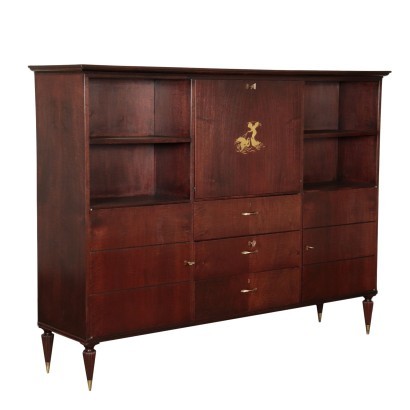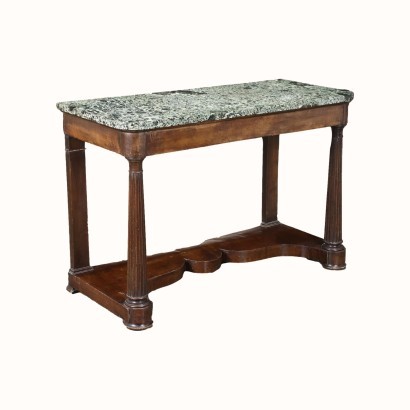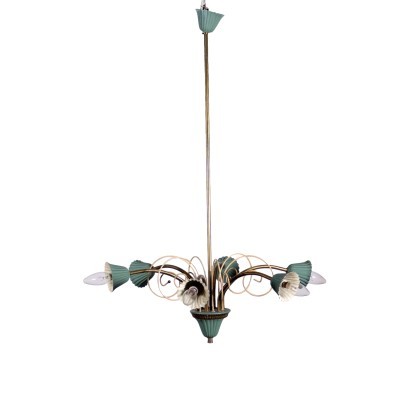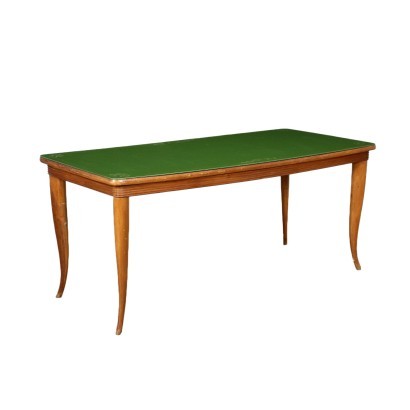Furniture attributable to Paolo Buffa - 1950s
Features
Designer: Attributable to Paolo Buffa
Production: Arrighi Serafino
Time: 1950s
Production country: Cantù, Italy
Main essence: Mahogany , Walnut
Material: Mahogany Veneer , Walnut Veneer , Brass
Description
A big piece of furniture usable on both sides designed by Paolo Buffa for Arrighi Stefano, shutter doors and drawers on one side. Open compartments and a drop-leaf door for the bar compartment on the other side. Mahogany veneer, walnut veneer interiors, brass legs ferrules. Manufactured in Cantù, Italy, 1950s.
Product Condition:
Very good condition. Wear consistent with age and use. Any damage or loss is displayed as completely as possible in the pictures.
Dimensions (cm):
Height: 98
Width: 226
Depth: 80,5
Additional Information
Designer: Paolo Buffa
Milano 1903-1970. Paolo Buffa è figlio d'arte. Il padre Giovanni era un pittore ed esecutore di vetrate i cui cartoni estremamente decorativi, pubblicati nelle riviste e manuali per artigiani, venivano proposti a modello di squisita "arte nuova". Paolo Buffa inizia a lavorare nello studio di Gio Ponti e in seguito, fin dal 1928, come risulta dalla documentazione d'epoca, in stretta collaborazione con l'architetto A. Cassi Ramelli. Si dedica prevalentemente all'arredamento, disegna mobili proponendo di continuo nuovi modelli. Più che un precursore, è un fedele portavoce del gusto del suo tempo: neoclassico prima e novecentista poi. Dal 1930 invitato alle Triennali, chiamato a partecipare ai concorsi dell'ENAPI, a collaborare alla rivista "Domus", può essere considerato uno degli arreda tori più autorevoli dell'area milanese. I primi mobili, realizzati nel 1927-28 durante la permanenza nello studio di Ponti e Lancia, dimostrano gran cura nella scelta dei legni, sul finire degli anni Venti Buffa introduce particolari stilistici orientali, per tutti gli anni Trenta adotta forme compatte e semplificate.
Production: Arrighi Serafino
Time: 1950s
1950s Main essence:
Mahogany
It is one of the most precious and sought-after woods in cabinet making. It was discovered in Central America around 1600 and began to be imported to England in the 1700s. Much appreciated for its hardness and indestructibility, it became widespread following the blocking of walnut exports from France in 1720 and the consequent elimination of English import duties on mahogany from the colonies in America and India. The most valuable version comes from Cuba, but it became very expensive. At the end of the 18th century it began to be used also in France in Louis XVI, Directory and Empire furniture, its diffusion declined starting from when Napoleon, in 1810, forbade its import. It was generally used in the manufacture of elegant furniture, due to its characteristics and beautiful grain.
Walnut
Walnut wood comes from the plant whose botanical name is juglans regia , probably originally from the East but very common in Europe. Light or dark brown in color, it is a hard wood with a beautiful grain, widely used in antique furniture. It was the main essence in Italy throughout the Renaissance and later had a good diffusion in Europe, especially in England, until the advent of mahogany. It was used for solid wood furniture and sometimes carvings and inlays, its only big limitation is that it suffers a lot from woodworm. In France it was widely used more than anything else in the provinces. In the second half of the eighteenth century its use decreased significantly because mahogany and other exotic woods were preferred. Material:
Mahogany Veneer
Walnut Veneer
Brass



